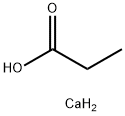Quizalofop-ethyl
Synonym(s):Ethyl 2-[4-(6-chloro-2-quinoxalinyloxy)phenoxy]propionate
- CAS NO.:76578-14-8
- Empirical Formula: C19H17ClN2O4
- Molecular Weight: 372.8
- MDL number: MFCD00128062
- SAFETY DATA SHEET (SDS)
- Update Date: 2024-12-18 14:07:02

What is Quizalofop-ethyl?
Chemical properties
White crystalline solid or powder. Commercial product is available as an emulsifiable con- centrate. Practically insoluble in water; solubili- ty≤2×10-28 ppm.
The Uses of Quizalofop-ethyl
Quizalofop-ethyl is a selective postemergence herbicide used to control both annual and perennial grasses in soybeans and cotton.
The Uses of Quizalofop-ethyl
Herbicide.
Definition
ChEBI: Ethyl 2-{4-[(6-chloroquinoxalin-2-yl)oxy]phenoxy}propanoate is an ethyl ester resulting from the formal condensation of the carboxy group of 2-{4-[(6-chloroquinoxalin-2-yl)oxy]phenoxy}propanoic acid with ethanol. It is an ethyl ester, an organochlorine compound, a quinoxaline derivative and an aromatic ether. It is functionally related to a 2-{4-[(6-chloroquinoxalin-2-yl)oxy]phenoxy}propanoic acid.
General Description
White crystals. Insoluble in water. Used as an herbicide.
Air & Water Reactions
Insoluble in water.
Reactivity Profile
A halogenated ester and amine. Amines are chemical bases. They neutralize acids to form salts plus water. These acid-base reactions are exothermic. The amount of heat that is evolved per mole of amine in a neutralization is largely independent of the strength of the amine as a base. Amines may be incompatible with isocyanates, halogenated organics, peroxides, phenols (acidic), epoxides, anhydrides, and acid halides. Flammable gaseous hydrogen is generated by amines in combination with strong reducing agents, such as hydrides. Esters react with acids to liberate heat along with alcohols and acids. Strong oxidizing acids may cause a vigorous reaction that is sufficiently exothermic to ignite the reaction products. Heat is also generated by the interaction of esters with caustic solutions. Flammable hydrogen is generated by mixing esters with alkali metals and hydrides.
Agricultural Uses
Herbicide: Not approved for use in EU countries. Registered for use in the U.S.
Trade name
ASSURE®[C]; DPX-Y 6202®; FBC®; 32197; INY-6202; MATADOR®; LEOPARD EC (p-isomer); MON® 78746; NC-302®; PILOT®; SUPER MATADOR (p-isomer); TARGA®; ULTRA TARGA (p-isomer)
Potential Exposure
A chlorophenoxy/aryloxyphenoxypro- pionate herbicide
Environmental Fate
Plant. Rapidly hydrolyzed in plants to quizalofop and ethanol (Humburg et al., 1989).
Shipping
UN3077 Environmentally hazardous substances, solid, n.o.s., Hazard class: 9; Labels: 9-Miscellaneous haz- ardous material, Technical Name Required.
Purification Methods
This (±)-herbicide forms white crystals from Me2CO/EtOH and sublimes in vacuo. Large quantities can be distilled at high vacuum. Its solubilities at 20o in g/10mL are 0.09 (EtOH), 1.1 (Me2CO), 1.2 (xylene), 2.9 (*C6H6), and is nearly insoluble in H2O (0.3mg/L). The (±)-acid has [95977-28-9]. The R-ester enantiomer has m 76-77o (pale brown crystals from EtOH), [ ] D 20 + 3 5 . 9o (EtOH). It is the more active fatty acid synthase inhibitor (designated DPX-Y6202) used to control grassy weeds in broadleaf crops.
Waste Disposal
It is the responsibility of chem- ical waste generators to determine the toxicity and physical properties and of a discarded chemical and to properly iden- tify its classification and certification as a hazardous waste and to determine the disposal method. United States Environmental Protection Agency guidelines for the classifi- cation determination are listed in 40 CFR Parts 261.3. In addi- tion, waste generators must consult and follow all regional, national, state, and local hazardous waste laws to ensure com- plete and accurate classification and disposal methods.
Properties of Quizalofop-ethyl
| Melting point: | 92-93° |
| Boiling point: | bp0.2 220° |
| Density | 1.2671 (rough estimate) |
| refractive index | 1.6800 (estimate) |
| Flash point: | 100 °C |
| storage temp. | 0-6°C |
| solubility | Chloroform (Slightly), Methanol (Slightly) |
| pka | -1.39±0.48(Predicted) |
| form | neat |
| Water Solubility | 303ug/L(temperature not stated) |
| Merck | 13,8178 |
| BRN | 7145610 |
| CAS DataBase Reference | 76578-14-8(CAS DataBase Reference) |
| NIST Chemistry Reference | Assure(76578-14-8) |
| EPA Substance Registry System | Quizalofop-ethyl (76578-14-8) |
Safety information for Quizalofop-ethyl
| Signal word | Warning |
| Pictogram(s) |
 Exclamation Mark Irritant GHS07  Environment GHS09 |
| GHS Hazard Statements |
H400:Hazardous to the aquatic environment, acute hazard |
| Precautionary Statement Codes |
P273:Avoid release to the environment. P280:Wear protective gloves/protective clothing/eye protection/face protection. |
Computed Descriptors for Quizalofop-ethyl
New Products
(S)-3-Aminobutanenitrile hydrochloride 4-Methylphenylacetic acid N-Boc-D-alaninol N-BOC-D/L-ALANINOL Tert-butyl bis(2-chloroethyl)carbamate 3-Morpholino-1-(4-nitrophenyl)-5,6-dihydropyridin- 2(1H)-one Furan-2,5-Dicarboxylic Acid Tropic acid 1-Bromo-3,5-Di-Tert-Butylbenzene S-2-CHLORO PROPIONIC ACID ETHYL ISOCYANOACETATE 2-Bromo-1,3-Bis(Dimethylamino)Trimethinium Hexafluorophosphate 4-IODO BENZOIC ACID 3-NITRO-2-METHYL ANILINE 1-(2,4-DICHLOROPHENYL) ETHANAMINE (2-Hydroxyphenyl)acetonitrile 4-Bromopyrazole 2-(Cyanocyclohexyl)acetic acid 4-methoxy-3,5-dinitropyridine 1-(4-(aminomethyl)benzyl)urea hydrochloride 2-aminopropyl benzoate hydrochloride diethyl 2-(2-((tertbutoxycarbonyl)amino) ethyl)malonate tert-butyl 4- (ureidomethyl)benzylcarbamate Ethyl-2-chloro((4-methoxyphenyl)hydrazono)acetateRelated products of tetrahydrofuran








You may like
-
 Quizalofop-ethyl CAS 76578-14-8View Details
Quizalofop-ethyl CAS 76578-14-8View Details
76578-14-8 -
 Quizalofop-ethyl CAS 76578-14-8View Details
Quizalofop-ethyl CAS 76578-14-8View Details
76578-14-8 -
 1975-50-4 98%View Details
1975-50-4 98%View Details
1975-50-4 -
 2-HYDROXY BENZYL ALCOHOL 98%View Details
2-HYDROXY BENZYL ALCOHOL 98%View Details
90-01-7 -
 2-Chloro-1,3-Bis(Dimethylamino)Trimethinium Hexafluorophosphate 221615-75-4 98%View Details
2-Chloro-1,3-Bis(Dimethylamino)Trimethinium Hexafluorophosphate 221615-75-4 98%View Details
221615-75-4 -
 61397-56-6 CIS BROMO BENZOATE 98%View Details
61397-56-6 CIS BROMO BENZOATE 98%View Details
61397-56-6 -
 14714-50-2 (2-Hydroxyphenyl)acetonitrile 98+View Details
14714-50-2 (2-Hydroxyphenyl)acetonitrile 98+View Details
14714-50-2 -
 118753-70-1 98+View Details
118753-70-1 98+View Details
118753-70-1